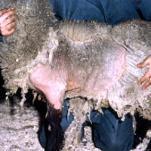
Richard Wall
Mange, caused by parasitic mites, is a damaging, distressing and difficult to control condition, seen in many types of domestic animal, particularly sheep and cattle. Of particular consequence is the disease known as ‘sheep scab’, caused by Psoroptes mites.
Psoroptes mites are small (less than 1 mm in length) and lack eyes. Their eggs hatch into six-legged larvae, and then two further moults take them through two eight-legged nymphal stages, before eventually the mite becomes an eight-legged adult. The mites have needle-like, barbed mouthparts called chelicerae which they use as they feed at the skin surface on a lipid emulsion of skin cells, bacteria and lymph. Serum oozes onto the skin surface as a result of inflammation and a hypersensitivity reaction to the presence of mite faecal material. The serum dries to form a yellowish crust, surrounded by a border of inflamed skin covered in moist crust. Mites are found on the moist skin at the edge of the lesion, which extends rapidly. It may take as little as six to eight weeks to cover three-quarters of the host’s body. Infestation leads to severe irritation and scratching, resulting in damage to the skin and hair; it causes severe welfare problems and death if untreated.
Sheep scab has been widely prevalent and economically important in Europe for many hundreds of years, but remains a major animal welfare, husbandry and economic problem today.
 Our research at the University of Bristol has shown that localised foci of persistent disease exist on particular farms, largely in upland farming systems, which act as reservoirs of infection.
Our research at the University of Bristol has shown that localised foci of persistent disease exist on particular farms, largely in upland farming systems, which act as reservoirs of infection.
One approach to improved control is to target these high-risk areas. To allow such an approach we are identifying and mapping risk foci in the UK using disease distribution models with environmental correlates. These models could allow management programmes to focus on high-risk areas, cost-effectively reducing the prevalence of scab in the UK.
Read more about the Food Security and Land Research Alliance.